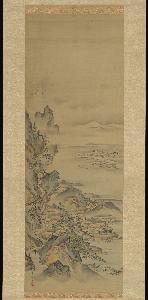Kano Tansui Moritsune
Moritsune;Kano Tansui Moritsune
Place: Tokyo
Biography:
Kano Tansui Moritsune was a Japanese painter from the Edo period (1615-1868). He was the son and pupil of Kano Tan'en Morizane and became the ninth-generation head of the Kajibashi Kano atelier. Moritsune was known for his work in ink and color on silk, including a triptych of hanging scrolls. He was also known by his alternate name, Moritsune.
Life and Career
Moritsune's life and career are not well-documented, but it is believed that he was born in the early 17th century and died in the late 17th century. He was a member of the Kano school, a prominent school of Japanese painting that was founded by Kanō Masanobu. The Kano school was known for its brightly colored and firmly outlined style, which reflected distinctively Japanese traditions. Moritsune's work was influenced by Chinese painting, but he developed a unique style that was characterized by strong outlines, bold colors, and extensive use of gold leaf. His paintings often featured natural subjects such as landscapes, birds, and flowers. Moritsune's work can be found in the Wikioo.org collection, which includes a range of Japanese paintings from the Edo period.
Style and Technique
Moritsune's style was characterized by his use of bold colors and strong outlines. He often used gold leaf to add a luxurious touch to his paintings. His technique was influenced by Chinese painting, but he developed a unique style that was distinctively Japanese. Moritsune's paintings often featured natural subjects such as landscapes, birds, and flowers. Some notable examples of Moritsune's work include Mount Penglai with Eight Views of Xiao and Xiang, which can be found in the Metropolitan Museum of Art collection. This painting features a landscape with bold colors and strong outlines, and is a prime example of Moritsune's style.
Influence and Legacy
Moritsune's influence on Japanese art cannot be overstated. He was a member of the Kano school, which was one of the most prominent schools of Japanese painting during the Edo period. His work influenced many other artists, including Kanō Tan'yū, who is considered one of the greatest Japanese painters of all time. Moritsune's legacy can be seen in the many paintings that he created during his lifetime. His use of bold colors and strong outlines helped to establish the Kano school as a major force in Japanese art. Today, Moritsune's paintings can be found in museums and collections around the world, including the Wikioo.org collection.
- Kano Tansui Moritsune was a Japanese painter from the Edo period (1615-1868).
- He was the son and pupil of Kano Tan'en Morizane and became the ninth-generation head of the Kajibashi Kano atelier.
- Moritsune's work was influenced by Chinese painting, but he developed a unique style that was characterized by strong outlines, bold colors, and extensive use of gold leaf.
- His paintings often featured natural subjects such as landscapes, birds, and flowers.
- Moritsune's influence on Japanese art cannot be overstated, and his legacy can be seen in the many paintings that he created during his lifetime.
Some notable links to Moritsune's work can be found on Wikioo.org and Wikipedia. These links provide more information about Moritsune's life, career, and influence on Japanese art.

